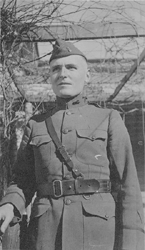
|
|
|
|
I brazenly copied this from the Kansas State Historical Web Site. The following link will take you to the original page until it is removed. http://www.kshs.org/cool3/purpleheart.htm
Purple Heart Medal "The day I was hit in the side they were sure coming around thick, one hit
my gat (pistol) and put it out of commission, another went thro the top of my
helmet, another went thro the bottom of my trench canteen and another went thro
one of my side pockets."
"The day I was hit in the side they were sure coming around thick, one hit
my gat (pistol) and put it out of commission, another went thro the top of my
helmet, another went thro the bottom of my trench canteen and another went thro
one of my side pockets."--Lt. George Robb, France, October 25, 1918 The Purple Heart medal is awarded to members of the armed forces who have been wounded or killed in action. The medal is seen as a symbol of bravery and sacrifice. George S. Robb was given the Purple Heart for displaying such qualities while serving in France during World War I. Originally from Assaria, Kansas, George entered the army in 1917 after graduating from Columbia University and teaching briefly in Great Bend. He was assigned to the 369th Infantry Regiment, anAfrican American regiment comprised of New York National Guardsmen from Harlem. On the night of Sept. 29th, 1918, George was wounded while leading an assault near Sechault, France. His actions that evening displayed such heroism that, along with the Purple Heart, George was awarded the Congressional Medal of Honor. The Purple Heart pictured here was given to George for injuries received on the battlefield. Though wounded in 1918, George would not receive the medal for at least fourteen years. Created by George Washington during the Revolutionary War, the award was not officially authorized by the Army until 1932. The authorization of the medal was retroactive specifically to commemorate wounded soldiers of World War I. 
The Purple Heart medal is awarded for a soldier's first wound, and oak-leaf clusters are added for additional wounds. The two clusters pinned to the ribbon indicate Robb was wounded at least three times during his military career. In George Washington's time, the Purple Heart was simply the figure of a heart in purple cloth or silk, edged with narrow lace. Robb's medal was designed in 1931, the bicentennial of Washington's birth, and consists of a purple enameled heart within a bronze border showing the relief of its creator (Washington) in his Continental Army Uniform. At the top of the enameled shield is Washington's family coat of arms. The aesthetically pleasing Purple Heart medal continues to inspire today. In 2003, the United States Postal Service released The Purple Heart Stamp. Considered a "definitive" stamp, it will be available for an indefinite period of time rather than the customary yearlong period for "commemorative" stamps. George Robb's Purple Heart medal was donated to the Kansas Museum of History by his estate in 1973. Check out the Cool Things Archive. From the KSHWeb Site |